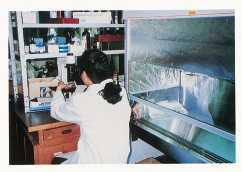
|
|
Study on the adaptation mechanisms to the hot tropical environment in human
beings and animals and its application of tropical medicine are the aims in
the Department, which was newly established in 1994. In collaboration with
the Department of Environmental Physiology, the following researches are on
going.
Study on long‐term heat acclimatization in tropical inhabitants
Core temperature, skin temperatures, local sweat rates, and metabolic rate
during heat load or exercise and Ach sensitivity of the sweat gland are compared
between Japanese and tropical inhabitants (Thai and Africans). It has been
revealed that in a hot environment, tropical inhabitants can efficiently regulate
their body temperature with less amount of sweat compared to Japanese, because
of their excellent dry heat loss ability(conduction, convection and radiation)
and suppression of ineffective sweating which drips off the skin. Suppressed
sweating in tropical residents is attributed to adaptation in both central(upward
shift of threshold core temperature for sweating and suppression of the gain)and
peripheral(suppression of Ach sensitivity of the sweat gland)sudomotor mechanisms.
This stucy is carried out in collaboration with the Department of Physiology,
Chiang Mai University, Thailand.
Study on cross‐adaptation of physical training to heat
After a short‐term physical training, heat tolerance is enhanced by the
activated sweat response. On the other hand, the athletes who trained for
a long time are tolerant to heat, as their sweat response is suppressed. The
roles of central and peripheral mechanisms are being investigated.
Study on cellular and molecular heat‐tolerance in temperature sensitive
mutant cells
The temperature‐sensitive mutant from mouse breast cancer cells, tsFT101,
is multinuclei when cultured at 39℃. The induction of thermotolerance and
also the induction of heat shock proteins due to pre‐heating at 45℃ for 30
min are very little in tsFT101 cells cultured at 39℃.The mechanisms of thermotolerance
in cellular and molecular level are under investigation by using this cell
line.
Study on cold adaptation in the weak heattolerant animal, pika(Ochotona)
The pika(Ochotona)living in the cold areas or high mountains attracts attentions
as an animal model of cold adaptation as well as highaltitude adaptation.
Th pika is intolerant to heat for lack of efficient heat loss mechanisms,
and does not hibernate in winter. To clarify the cold adaptation mechanisms
in pikas, physiological studies on atonomic and behavioral thermoreguration,
anatomical studies and the field studies in their natural habitats in China
and Mongolia are on going.
Comparison of thermal adaptability among tropical, subtropical and temperate
subjects
We compare the natural environmental adaptability through out the effect
of environmental temperature and sunlight on functional, morphological, and
organic changes in tropical(Thai), subtropical (Nepal) and temperate(Japanese)subjects.
Professor (concurrent)
Research Associate Eiko kaneda

Experiment of thermal sweating in the environmental chamber

Laboratory of cell culture